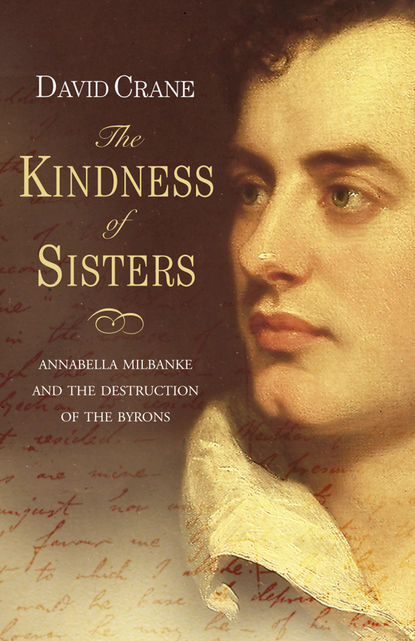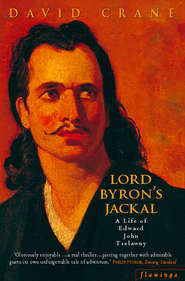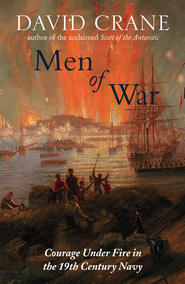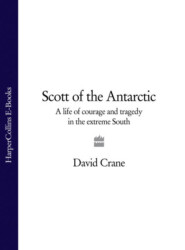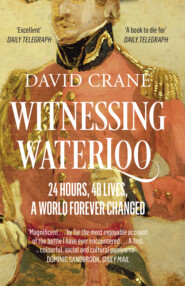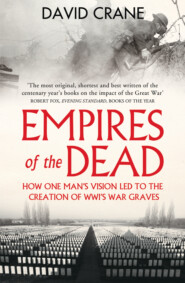По всем вопросам обращайтесь на: info@litportal.ru
(©) 2003-2024.
✖
The Kindness of Sisters: Annabella Milbanke and the Destruction of the Byrons
Настройки чтения
Размер шрифта
Высота строк
Поля
On a chill and blustery Tuesday in April 1851, an elderly woman, accompanied by a man in his early thirties, emerged from the entrance at the top of Trafalgar Street in Brighton to take the north-bound railway for Reigate. If anyone in the crowded terminus had noticed either of them it would almost certainly have been the man, a tall and striking figure, whose charismatic preaching at the Holy Trinity had made the names of ‘Brighton’ and ‘Robertson’ synonymous across the English-speaking protestant world.
With her air of genteel invalidism, and discreet, unassuming appearance, it is unlikely that the woman beside him would have attracted a second glance. She had never been more than five foot three in height and in her late fifties seemed scarcely that, a fragile, neat creature with a slight, ‘almost infantine’
(#litres_trial_promo) figure, fine delicate hands, deep and striking blue eyes, silver hair, high forehead, and the preternatural pallor of the permanent invalid.
To the circle of her friends, in fact, who watched over her prolonged decline with a complete and willing devotion, it seemed that Annabella Byron hardly belonged to this world at all. There was a calm certainty about her that struck a note of unearthly detachment, an ethereal refinement that seemed to the chosen ‘soulmates’ of these last years to be that of ‘one of the spirits of the just made perfect … hovering on the brink of the eternal world’
(#litres_trial_promo).
If anyone had taken a closer look at this pair, however, as they made their way under the soaring gothic of Brighton’s new terminus to the first-class carriages of the London train, there would have been little doubt where the balance of power lay. Thirty five years earlier the young Annabella Byron had appeared to her sister-in-law less as a visiting angel than an avenging spectre, and in the remote and concentrated self-possession of her bearing, it was as if all the frailties or pleasures of life had been purged away to leave behind only a pure, indomitable will.
And yet behind this ‘miracle of mingled weakness and strength’
(#litres_trial_promo), as Harriet Beecher Stowe called her, there was a nervousness, an emotional and physical excitability, that raged all the fiercer for its ruthless suppression. In a self-portrait she wrote in the last year of her life she spoke of the ‘burning world within’
(#litres_trial_promo) that so few ever saw, and as she took her place beside Robertson, and sat compulsively folding and refolding her scrap of paper with its illegible instructions to herself on it, she knew only too bitterly the cost at which any outward calm had been won.
If she had caught her reflection in the glass before it was swallowed up in the blackness of the Clayton tunnel, she would have been forced to recognise there the evidence of the same grim truth. Forty years earlier, in her second London season, Hayter had painted her with the louche abandon of some Regency Magdalene, but if she had looked now for the face of the young Annabella Milbanke in the reflection that stared back, searching for some trace of all those potentialities and hopes that were frozen when pain and humiliation petrified her strength into the obduracy of a long widowhood, she would have looked in vain.
There would have been something in its unyielding expression, however, in the set of the mouth, in the air of conviction, the concentration, that anyone who had seen her as a child would have had no difficulty recognising. Some years after her death Robertson’s biographer, Frederick Arnold, remarked on the doctrine of ‘personal infallibility’ to which Annabella Byron subscribed in these late years, and if a lifetime of alternating sycophancy and hostility had done their worst to make her what she was, the foundations at least of her old age were laid in the cosseted, self-absorbed childhood of Annabella Milbanke.
To have any real sense of the woman in the train bound for Reigate, or the forces that had shaped her life, it is necessary to go back even further than that, to another generation and world that is best glimpsed in a family portrait by Stubbs that now hangs in the National Gallery in London. On the left of Stubbs’s grouping a young woman of seventeen sits high in the seat of a light carriage, reins and whip competently and prophetically in hand, her face, simultaneously ‘unfinished’ and determined, framed by a white bonnet, her eyes boldly, almost immodestly, engaging with a future that seems in her control.
The girl, Elizabeth Lamb, is pregnant, although it is impossible to tell from the painting. At her side, her father, Sir Ralph Milbanke, his expression serious, leans against the carriage; in the centre, holding the reins of a dappled grey that matches her carriage pony, stands her brother, John; on the right, slightly apart, elegant in profile on a superb bay, is her husband of a year, Peniston Lamb, the future first Lord Melbourne.
There is a sense of calm to the piece, a reserve and unforced serenity that can only come of an unconscious collaboration of artist and sitters. In the distance a rocky outcrop looms over a stretch of water with some vague suggestion of domesticated wildness, but Stubbs’s figures need no background, confidently filling their social and pictorial space, sufficient to themselves under the enveloping protection of a darkly spreading oak.
The oak and the girl, the past and the future, both linked in an unbroken chain to which the figures bear silent, unruffled witness. There is no conversation in this ‘conversation piece’, no interaction almost, just a shared strength that needs no articulating. From the side Peniston Lamb looks across – as well he might – to his formidable young wife, but the gaze is unreturned. Even the horses seem entirely self-contained, blinkered or cropping the grass, indifferent to each other, their owners, or the two dogs that, like a pair of attendant saints, stare up, in that eternal gesture of English portraiture, with unnoticed devotion at their masters.
There is none of the golden glow of other Stubbs paintings here, none of the bucolic ease of his Haymakers, but a cool silvery light warmed only by the pink of Elizabeth’s dress and the answering tinge of the clouds. On a nearby wall an elderly couple also painted by Stubbs aboard their phaeton might be Jane Austen’s Admiral and Mrs Croft, but this group is not about affection or fulfilment but hierarchy and power, about dynastic and cultural certainties, and about what David Piper memorably called that ‘obscure but potent directive of fate’ that gives Stubbs sitters their air of unchallenged and unchallengeable authority.
According to tradition, the Milbanke family traces itself back to a cup-bearer at the court of Mary Queen of Scots, who fled the country after a duel, settling in the north of England. Whatever the maverick promise of these origins, however, the next two hundred years saw a blameless decline into respectability, all taint of romance erased, in a family progress that took the Milbankes from Scottish exile by way of aldermanic and mayoral office in Newcastle to a baronetcy and a safe seat in Parliament.
It was Charles II who granted the title to the first Sir Mark Milbanke in 1661, and over the next century the Milbankes’ influence was consolidated in the network of alliances and marriages that inevitably underpinned eighteenth-century political life. In generation after generation of Sir Marks or Sir Ralphs the same pattern emerged, as the Milbankes of Halnaby Hall married into other northern families, extending their land and connections across the north-east of England, augmenting agricultural interests in one marriage or mineral interests in another before, in the middle of the eighteenth century, forging the key alliance with the powerful Holderness family that gave Stubbs’s 5th Baronet a place in the Commons.
There is something so reassuringly dull about the Milbankes’ political careers, so entirely lacking in individuality, that one feels instinctively with them that one is in touch with the solid bedrock of Sir Lewis Namier’s England. Sir Ralph had first entered parliament as one of two unopposed members for Scarborough in 1754, and at the first election of the new reign stood in the Holderness interest for Richmond, loyally and uncritically supporting successive administrations, before retiring in 1768 without having spoken a single word in fourteen years an MP.
Over twenty years were to pass before another Milbanke sat in Parliament, but through the 1770s and 80s Sir Ralph’s son, another Ralph, continued the same process of family consolidation, hitching his political fortunes first to Lord Rockingham and then, on his death, to Charles James Fox. In 1790 after a ruinous campaign that is reckoned to have cost the family £15,000, he was finally returned in second place for Durham Co, and for the next twenty-two years remained its MP, a genial and ineffectual ‘Uncle Toby’ whose fidelity to the Whig cause, in his daughter’s succinct phrase, was ‘as little valued as doubted’.
(#litres_trial_promo)
It was into this family and this world, on 17 May 1792, that Anne Isabella Milbanke was born. The future Lady Byron has always seemed to belong so completely to the nineteenth century that it is easy to forget that this is where her roots lie, that her moral and social being was shaped by the inherited virtues and limitations implicit in Stubbs’s painting or her family’s dilettante public service.
But if the young Annabella was brought up in a political milieu, behind the web of alliances and obligations that supported two generations in parliament lay realities of landed life that had a far more profound effect on her vision. From the middle of the seventeenth century the principal seat of the Milbankes had been Halnaby Hall, a red-bricked Jacobean manor house, now gone, that lay just off the Great North Road outside the village of Croft in Yorkshire. In the village church of St Peter’s a wonderfully grandiose tomb and pew still evoke the dynastic ambitions of the early Milbankes, but Annabella’s affections remained all her life with the modest estate at Seaham on the north-east coast where she grew up. ‘If in a small village’, she recalled many years later, in a passage that might have come from George Eliot,
you cannot go out of the gates without seeing the children of a few Families playing on the Green, till they become ‘familiar faces’, you need not be taught to care for their well-being. A heart must be hard indeed that could be indifferent to little Jenny’s having the Scarlet Fever, or to Johnny’s having lost his mother … I did not think property could be possessed by any other tenure than that of being at the service of those in need.
(#litres_trial_promo)
The Milbankes and Seaham may have given Annabella a sense of the rooted interdependency of country life, but through her mother she could lay claim to a more exotic strain of English history. Judith Noel was born in 1751, the eldest daughter of Sir Edward Noel of Kirkby Mallory, first Viscount Wentworth and heir through the contorted female line to the sixteenth century Wentworth barony. It would be dangerous to describe any title that has survived with the tenacity of the Wentworths as ‘doomed’, but when a family branch can provide a Lancastrian standard-bearer at St Albans, a Governor of Calais under Mary Tudor, and the devoted mistress to the Duke of Monmouth, it is at least guilty of the kind of ill-luck that might pave the way to a marriage with Byron.
For someone so outwardly prosaic as Annabella, there was, too, a curiously vivid streak of romanticism that fed directly off her sense of history. In a self-portrait written as a woman of thirty-nine, she looked back on her childhood self, on a miniature Dorothea Brooke pulled backwards and forwards between the claims of the imagination and the stern imperatives of a protestant conscience. ‘Impressed from earliest childhood with a sense of duty, and sympathising with the great and noble in human character’, she wrote,
my aspirations went beyond the ordinary occasions of life – I wasted virtuous energy on a visionary scene, and conscience was in danger of becoming detached from that before me. Few of my pleasures were connected with realities – riding was the only one I can remember. When I climbed the rocks, or bounded over the sands with apparent delight, I was not myself. Perhaps I was shipwrecked or was trying to rescue other sufferers – some of my hours were spent in the Pass of Thermopylae, others with the Bishop of Marseilles in the midst of Pestilence, or with Howard in the cheerless dungeon …
About the age of 13… I began to throw my imagination into a home-sphere of action – to constrain myself, from religious principle, to attend to what was irksome, and to submit to what was irritating. I had great difficulties to surmount from the impetuosity and sensitiveness of my character … It was this stage of my character which prepared me to sympathise unboundedly with the morbidly susceptible – with those who felt themselves unknown …
(#litres_trial_promo)
It would clearly be absurd to try to define her exclusively in terms of ancestry, but there is a sense in which the solidity of the Milbankes and the romanticism of the Wentworth inheritance combined to produce in Annabella something distinctly new, a kind of fierce ordinariness, a strident centrality that raised the commonplace to the realms of genius, orthodoxy to the stuff of crusade.
Along with this dual inheritance, the circumstances of her own contented upbringing can only have sharpened the feeling of singularity with which she coloured the most ordinary imaginative experiences of childhood. In the same Auto-Description she lamented a ‘want of comparison’ in her Seaham life that blinded her to the advantages of birth, and yet of greater importance than the inevitable isolation of a small Durham village was the simple fact that she was the only child of parents who had waited fifteen years for an heir.
Ralph Milbanke and Judith Noel had married in 1777, and although they had brought up a niece as if she was their own child, there is no mistaking the ferocious joy that greeted Anna-bella’s birth. It is often admiringly noted that she was encouraged in her opinions from her earliest days, but if her childhood self can be back derived from her adult character, hers was the kind of independence that might have flourished more safely in the face of opposition than indulgence, her character one that would have fared better outside the warmth and admiration of a family that placed her firmly and uncritically at its centre. ‘It was indeed Calantha’s misfortune to meet with too much kindness,’ her cousin Caroline Lamb wrote of herself in a passage in Glenarvon that throws an unexpected light on this – a passage that sufficiently stung Annabella when she read the novel to have her mark and angrily refute its psychology in a criticism that survives still among her papers,
or rather too much indulgence from all who surrounded her. The Duke, attentive solely to her health, watched her with the fondest solicitude, and the wildest wishes her fancy could invent, were heard with the most scrupulous attention, and gratified with the most unbounded compliance.
(#litres_trial_promo)
This regime of indulgence was made more dangerous in Anna-bella’s case by an intelligence that in and outside the home had little to challenge it. Even as a child she was conscious of being cleverer than most of those around her, but it was a cleverness dangerously at the service of unchallengeable moral certitudes, an intelligence that seems never to have broadened with reading or turned on itself in any genuine spirit of criticism. From the evidence of her letters and journals there was certainly a kind of scrupulousness about her, and yet even here her scruples and self-doubts were, like her shyness, the self-referential workings of an imagination that ultimately appealed to no other judgement but its own.
If Annabella Milbanke had simply married as Milbankes had traditionally married, none of this might have much mattered, and it is likely that she would have done no more than add one more name to history’s forgotten roll of mute, inglorious husbands. From the earliest family descriptions one can glimpse the formidable chatelaine she should have been, but substitute the name Byron for that of George Eden or any of her earlier suitors, see that ten-year-old girl with the determined pout Hoppner painted as the future Lady Byron, and the warmth, the love, the privilege and security of her sheltered upbringing suddenly seem the laboratory conditions for breeding the disaster of the most notorious marriage in literary history.
It is the inevitable condition of biography to shape a life with the benefits of hindsight in this way, and yet it is only hindsight that casts a shadow over the prelapsarian happiness of Annabella’s childhood. In her own eyes the memories of Seaham would always have the poignancy of blighted innocence, but the horror is that it could have ever equipped anyone so essentially limited in experience or culture to imagine that she could understand or tame a Byron.
It is often forgotten, in the feeding frenzy that invariably accompanies her name, how vulnerably young she was when she first met him in 1812, and yet nothing suggests that another summer or two would have made the difference. She had come up to London for her first season in the previous year, and although there were suitors enough to satisfy anyone’s vanity, not even a future governor-general of India or Wellington’s adjutant general in the Peninsula had been sufficient to jolt her out of the complacent certainties of her Seaham world. ‘I met with one or two who, like myself, did not appear absorbed in the present scene’, she later wrote of this period,
and who interested me in a degree. I had a wish to find among men the character I had often imagined – but I found only parts of it. One gave proofs of worth, but had no sympathy for high aspirations – another seemed full of affection towards his family, and yet he valued the world. I was clear sighted in these cases – but I was to become blind.
(#litres_trial_promo)
It was a misfortune, too, for a woman who could think like this to see her future husband for the first time in his annus mirabilis, because if there were far more interesting ‘Byrons’ than the triumphant author of Childe Harold, there was none more likely to appeal to a romantic moralist of Annabella’s stamp. ‘Lavater’s [the phrenologist] system never asserted its truth more forcibly than in Byron’s countenance’, the portrait painter Sir Thomas Lawrence wrote at the height of Byron’s fame, wonderfully capturing the mix of glamour and threat in the figure that seduced London’s ‘golden parallelogram’ in the spring and summer of 1812,
in which you see all the character: its ken and rapid genius, its pale intelligence, its profligacy, and its bitterness; its original symmetry distorted by the passions, his laugh of mingled merriment and scorn; the forehead clear and open, the brow boldly prominent, the eyes bright and dissimilar, the nose finely cut, and the nostril acutely formed; the mouth well made but wide and contemptuous even in its smile, falling singularly at the corners, and its vindictive and disdainful expression heightened by the massive firmness of the chin, which springs at once from the centre of the full under-lip; the hair dark and curling but irregular in its growth; all this presents to you the poet and the man; and the general effect is heightened by a thin spare form, and, as you may have heard, by a deformity of limb.’
(#litres_trial_promo)
Byron was just twenty-four when, after more than two years’ travel across Europe and the east, the sudden and unprecedented success of Childe Harold changed his life and the course of Romantic literature. He had already produced some feeble juvenilia and a long and scabrous satire he had since come to regret, but nothing in his literary or private life, nothing in the intense and homoerotic friendships of his Harrow and Cambridge days or the bisexual philandering in the Levant had prepared him emotionally for the loneliness of fame that swamped him on his return, a poet without conviction, an aristocrat without a sense of belonging, a liberal without the stamina or will for political life, an icon with a morbid sensitivity to his lameness.
It would have been odd in fact if Annabella alone had not felt drawn to Byron that summer, and yet even in the privacy of her diary and letters she felt she owed her intelligence some more refined expression of her feelings than the general excitement that gripped Regency society. She had first seen him at a morning waltzing party given by Caroline Lamb on 25 March, and after filling her journal that night with her impressions, the next day reported back to her mother in Seaham. ‘My curiosity was much gratified by seeing Lord Byron, the object at present of universal attention’, she wrote,
Lady Caroline has of course seized on him, notwithstanding the reluctance he manifests to be shackled by her … It is said that he is an infidel, and I think it probable from the general character of his mind. His poem sufficiently proves that he can feel nobly, but he has discouraged his own goodness. His features are well formed – his upper lip is drawn towards the nose with an expression of impatient disgust. His eye is restlessly thoughtful. He talks much, and I heard some of his conversation, which is very able, and sounds like the true sentiments of the Speaker.
I did not seek an introduction myself, for all the women were absurdly courting him, and trying to deserve the lash of his satire. I thought that inoffensiveness was the most secure conduct, as I am not desirous of a place in his lays. Besides, I cannot worship talents that are unconnected with the love of man, nor be captivated by that Genius which is barren in blessings – so I made no offering at the shrine of Childe Harold, though I shall not refuse the acquaintance if it comes.
(#litres_trial_promo)
The acquaintance finally came the next month at a party of Lady Cowper’s, and with it the note of ironic detachment became increasingly hard to sustain. In her letters home to her mother she continued to insist that ‘calm benevolence’





